Serviços Personalizados
Journal
Artigo
Indicadores
-
 Citado por SciELO
Citado por SciELO -
 Acessos
Acessos
Links relacionados
-
 Citado por Google
Citado por Google -
 Similares em
SciELO
Similares em
SciELO -
 Similares em Google
Similares em Google
Compartilhar
CT&F - Ciencia, Tecnología y Futuro
versão impressa ISSN 0122-5383versão On-line ISSN 2382-4581
C.T.F Cienc. Tecnol. Futuro v.4 n.1 Bucaramanga jan./jul. 2010
2Universidad Industrial de Santander, Bucaramanga, Santander, Colombia
3Ecopetrol S.A. - Instituto Colombiano del Petróleo, A.A. 4185 Bucaramanga, Santander, Colombia
4Universidad Industrial de Santander, Bucaramanga, Santander, Colombia
e-mail: javieroswaldomendoza@gmail.com darwin.mateus@ecopetrol.com.co
(Received, April 15, 2009; Accepted June 16, 2010)
* To whom correspondence may be addressed
ABSTRACT
The main objective of this article is to raise a hypothesis to explain the main causes of overpressure in the formations of the Tertiary sequence for the stratigraphic column of the Colombian Foothill. For this purpose it was conducted an analysis of compaction trends from the Guayabo Formation until the unit C8 of the Carbonera Formation; in the area of foreland, where the tectonic affectation has been minimal. This analysis integrates the most representative basins modeling and tectono-stratigraphic events for such sedimentary sequence. It mapped overpressure areas, comparing them with geological parameters such as the subsidence, uplift, heat flow and speeds of sedimentation, to identify relations of these parameters with the overpressure of the area.
As the main result, it stresses the identification of different sedimentation and compacting rates for each tectono-stratigraphic sequence and its relationship with the overpressure of the formations. These differences are represented in specific equations presented in this work.
One of the main conclusions relates the rapid uplift of the basin, occurred in mid Miocene and the lack of liberation of stresses; as one of the causes of the pressures that are currently observed.
Palabras clave: trend of compaction, overpressure, pore pressure, velocity of sedimentation, subsidence, tectono-stratigraphics events.
RESUMEN
El objetivo principal de este artículo es plantear una hipótesis que explique las principales causas de sobrepresión en las formaciones de la secuencia terciaria para la columna estratigráfica del Piedemonte llanero colombiano. Para este fin se realizó un análisis de las tendencias de compactación desde la Formación Guayabo hasta la unidad C8 de la Formación Carbonera, en el área del foreland, donde la afectación tectónica ha sido mínima. En este análisis se integro el modelamiento de cuencas y los eventos tectono-estratigraficos más representativos para dicha secuencia sedimentaria. Se elaboraron mapas de las zonas sobrepresionadas, comparándolas con parámetros geológicos como la subsidencia, levantamiento, flujo de calor y velocidades de sedimentación, para identificar relaciones de estos parámetros con la sobrepresión del área.
Como principal resultado se destaca la identificación de diferentes tasas de sedimentación y compactación para cada secuencia tectono-estratigrafica y su relación con la sobrepresión de las formaciones. Estas diferencias están representadas en ecuaciones específicas que se presentan en este trabajo.
Una de las principales conclusiones relaciona el rápido levantamiento de la cuenca, ocurrido a mediados del Mioceno y la falta de liberación de esfuerzos; como una de las causas de las presiones que se observan actualmente.
Key words: tendencia de compactación, sobrepresión, presión de poro, velocidad de sedimentación, subsidencia, eventos tectono-estratigráficos.
INTRODUCTION
One of the main problems of instability in the Colombian Foothill is associated with the Cavings' high volumes, produced by overpressed shales. For this reason is crucial to understand the mechanisms that generate the overpressure and quantify its magnitude for such formations.
According to the under-compacting theory (Bowers, 1995); the burial history of clay formations, has direct implication in the pressures that these actually present, so that the slower is the subsidence rate, the fluids have more time to escape and consequently would expect lesser pressure values. In the same way, at faster rates of subsidence, greater pressures are obtained.
In this paper, we apply the methodology proposed by Magara in 1978, which is based on the analysis of the normal compaction trends that reflect the speeds of sedimentation associated with the main tectono-stratigraphic events occurred in the region. Equations, geohistorical models and maps are presented, that represent the behavior of the compaction trends in the Colombian Foothills and as a basis for defining future pore pressure profiles more consistent with the behavior of the wells and therefore more suited to be implemented in geomechanical models of subsequent studies.
THEORICAL FRAMEWORK
Compaction is the phenomenon referring to the loss of porous space within a sedimentary body originated by the vertical load of the overlying layers, however, there are circumstances in which the loss of porosity is the result of lateral efforts, explains Terzaghi & Peck (1948).
The normal compaction curve when the speed is expressed in logarithmic scale, is a straight line and is known as the Normal Trend of Compaction, (i.e., the state of balance between the pressure exerted by the overlying sediments and the reduction of porous spaces by expulsion of fluids (Magara, 1978). (Figure 1).
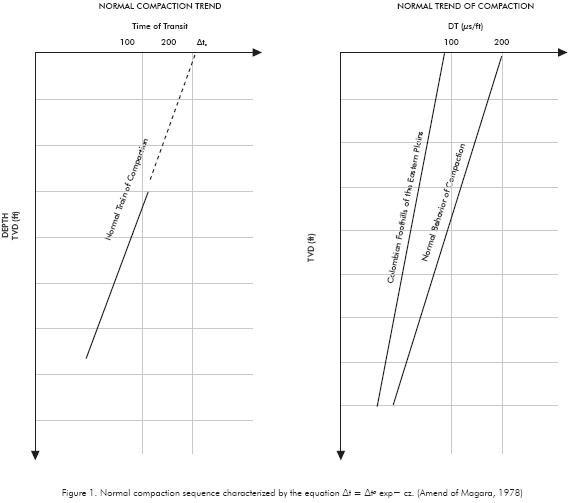
If the sonic transit time is logarithmically linked with the depth in linear scale, the readings towards the shales must fall on this straight line, for an area of normal compaction (Magara, 1978). The line that corresponds to pure and homogeneous shale is expressed mathematically in such way in the Equation 1.
Where:
Δt is the time of transit (µs / feet) to depth Z (feet),
Δtο is the extrapolated transit time to surface and
C is a constant (feet-1) which represents the slope of the normal train of compaction.
Taking the natural logarithm on both sides, the equation is obtained 2, (Magara, 1978):
The ideal behavior, where compaction is flush with the pore pressure for a basin that has not been subject to uprisings nor a great processes of erosion, assumes a theoretical value of transit time (200 µs/ft) for the normal trend; (Figure 1a), while in basins with large thicknesses eroded, subject to tectonic processes such as the basin of the Eastern Plains this value is going to be lower. (Figure 1b).
The value of the C slope is proportional to the sedimentation speed. In the case of a relatively slow sedimentation, the grains of the shale have enough time to accommodate causing a greater reduction of the porous with the burial. On the contrary, if the sedimentation speed is very quick, the grains of shale do not have enough time to rearrange, resulting in a minor reduction of the porous with the depth and the slope (C) is more vertical that in the previous case (Magara, 1978).
Models used in the compaction study
Burial Model. Through burial curves can observe the variations that suffer the formations through the geological time, both of depth and pressure (Figure 2a).
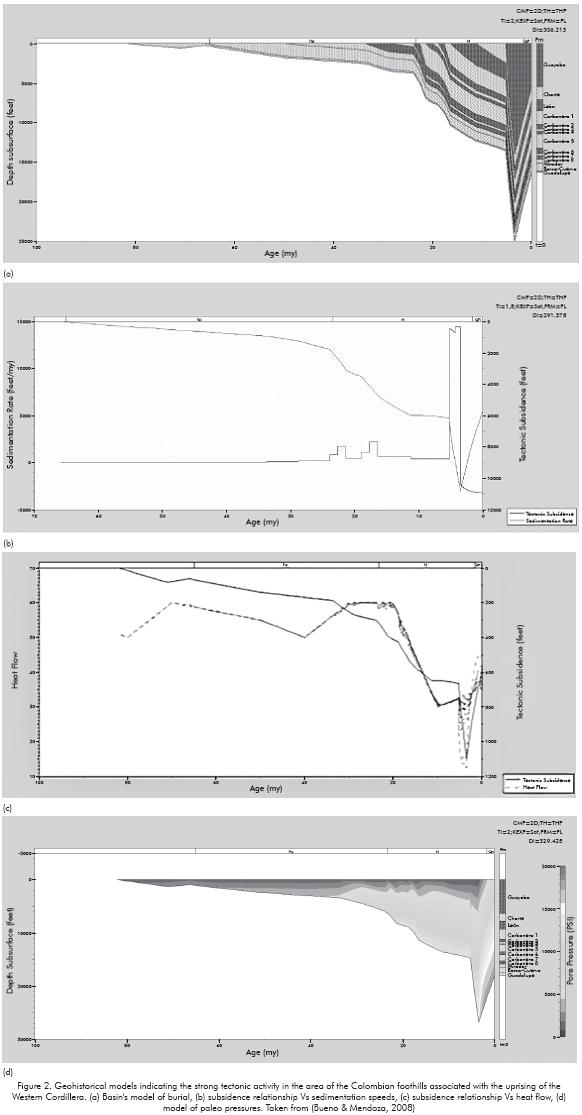
This study identified the main tectono-stratigraphic events in the area of study, with the aim of understand its relationship with the variations of the compaction trends observed in the sonic logs and find an explanation to the overpressure of the area. (Figure 2b)
Thermal Model. A temperature model is essential for the calibration of basins modeling, for this study began with the analysis of data of temperatures from the wells in the sector (BHT) and was built with the data of reflectance of the vitrinite, which is indicative of paleotemperature, the heat flow history for the basin (Figure 2c)
Model of pressures. The pressures observed in the current formations are the result of the evolutionary history of the basins, so that models may be used to rebuild the history of paleopressures and understand the possible causes of the anomalies that these present (Figure 2d).
Location of the study area
The study area is located in the Basin of the Eastern Plains (Figure 3); it is an asymmetrical basin east of the Andes and is part of the Subandean Basins of Antepais limited at the West by the Foothill of the Eastern Cordillera, to the East by the Precambrian Shield of Guyana and at the South by the Serranía de La Macarena and the Arco de Basamento. (Bueno & Mendoza, 2008).
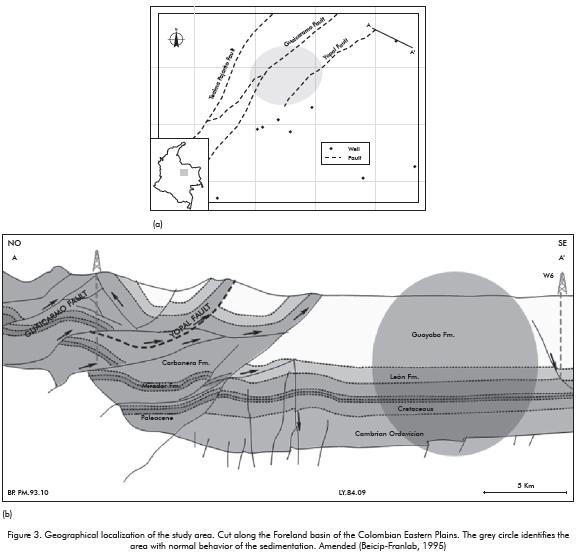
METODOLOGY
For the analysis of compaction of the basin of the eastern plains, the following methodology was used. (Figure 4).
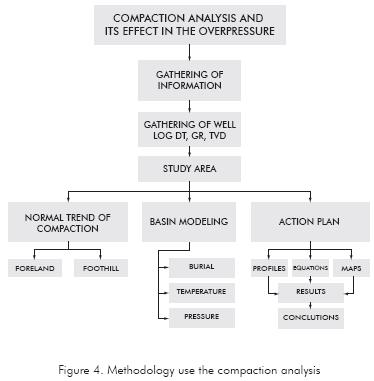
1. Gathering of information
Based on Ecopetrol's well logs, values of TVD, DTs, GR were taken, for analysis of compaction trends and geochemical, stratigraphic data, to make the evolutionary model and the behavior of the pressure in the basin of the Colombian Eastern Plains.
2. Elaboration of normal trends of compaction
Taking into account the most representative wells, based on maximum coverage of the sonic log, its distribution in the basin in areal and structural style, the clay levels were selected from the Gamma Ray log, then proceeded to read the intervals of transit time (Sonic log) in terms of depth, in order to build the compaction profiles in the selected wells in the foothills and along the Foreland, identifying those which submitted more complete sequences and with higher values of transit time on the surface, allowing to trace the normal compaction represented by equations (Table 1) following the methodology proposed (Magara, 1978).
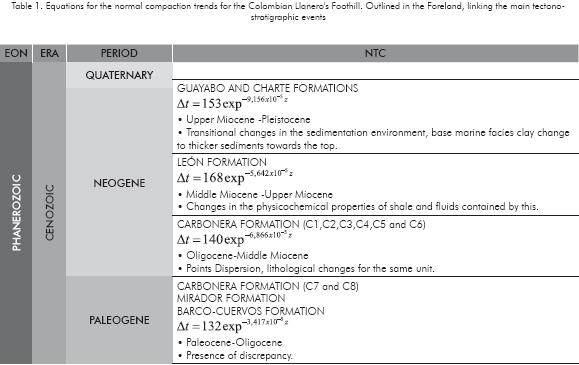
Several wells that would have adequate information to determine the Compaction Trends in the Foreland area of the Colombian Eastern Plains basin where studied. That area represents a normal compaction behavior, given geological features such as; minimal structural deformation, more complete stratigraphic sequences and minimum eroded thickness as proposed by Magara, (1978).
3. Construction of the models used for the overpressure analysis
Burial, thermal and pressure models were prepared , based on tectonic events, stratigraphic data (targets thicknesses), well data (BTH) and geochemical data (vitrinite reflectance), linking the normal trend lines, in order to take into account major compaction events over time.
4. Integration of geohistorical events and its influence in the pressures behavior
The compaction trend for Cretaceous formations reflects a uniform provision due to the high compaction state generated by the burden of the superjacent units and the maximum depths reached during the burial of the basin, which is evident with a wide range of transit time and the advanced diagenesis for these formations. (Figure 6).
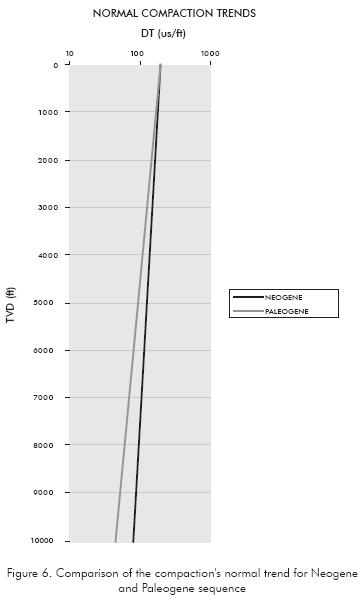
The compaction trend lines for the Paleogene indicate that the sedimentation rates were slow, related to the rapid regression and the presence of continental and transitional deposits, which constitute the formations of Barco, Cuervos, Mirador and the C8 and C7 members. (Figure 7a).

Once defined the Neogene sequence, was noted that for the Middle Oligocene-Miocene presented flexural subsidence related by the lifting of the Central and Western ridges identified in the geo-historical diagram (Figure 2a); at the same time, compression is reported in the basin which generates structures that caused a greater accommodation space and increased the contribution of sediment. In this period was carried out the sedimentation of the sequences C6, C5, C4, C3, C2 of Carbonera (Figure 7b).
In the sequence of Middle Miocene-Upper Miocene (León Formation) was observed the higher slope of the trend lines (Figure 7c), with an increase in the transit time values as a consequence of the high rates of sedimentation and a greater contribution of continental sediment generated during this period of compression and inversion, which rises the Eastern Cordillera.
The Andean deformation during the Upper Miocene- Pleistocene generated a reversal of the original basin, depositing the Guayabo Formation, which consists of continental and transitional deposits, marked by a more diverse litho logic contribution (conglomerates, coarse sands, silt, clay) than the León and Carbonera's sequences. This constitution allows the fluid release to be balanced by increasing the diagenesis and overloading, leading to a more horizontal inclination (Figure 7d) for the compaction profile and thus a more normal pressure.
5. Analysis of the overpressure in the basin of the Colombian Llanos
The compaction trends for the Foreland area and the trends found in the Foothills were compared, noting that both, in the Foreland and in the foothills existed or occured variations in the sedimentation rates among the formations which explain the variations in pressures found during boreholes drilling operation.
Finally, all the well data and basin modeling were integrated to support the presence of overpressure in the Colombian llanero's foothills, which are represented on maps of pressure distribution for the study area.
RESULTS
The León Formation presented the highest slope regarding the compaction trends in the Foreland, interpreted as a result of the high sedimentation rates. This implies an imbalance between the load of sediments and pore fluid expulsion as they were deposited. Confirming the findings in the geohistorical diagrams used in this investigation and compared with the work of Peñaloza & Ramírez, 1993. Which conclude that there is a great influence in the lifting of the Eastern Cordillera with sedimentation rates in the mid-Miocene. These abnormal pressures were measured with direct data in wells of the foothills (Figure 8).
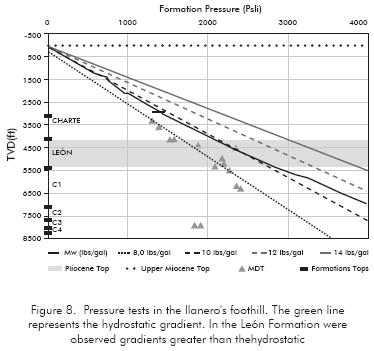
In general, the highest values of the tectonic subsidence for the Plains' basin are presented in the SW, because in those areas the lithosphere has suffered the most thinning towards the areas with the highest elevation of the mountain chain. Maintained between the foreland, shows a decrease in the subsidence values, due to the asymmetry of the basin. (Figure 2a).
The highest values of pore pressure and the higher subsidence show a trend towards the NE of the Cupiagua Field, which clearly correlates with the results of the sedimentation rates (Figure 9), heat flow and tectonic subsidence. It is therefore concluded that properly framed, the geological model of the area, will allow understanding the causes that generate overpressures and its direct relationship with these abnormal areas.
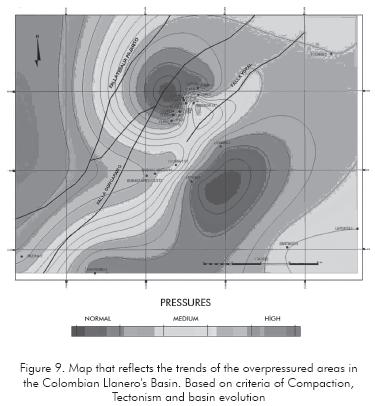
CONCLUSIONS
- The basins' evolutionary model had a good adjustment with the temperature data measured in wells in the sector, as well as with geochemical data (vitrinite reflectance). In this model is highlighted the Miocene subsidence event, which generated a greater accommodation space and an increase in the contribution of sediments, favoring the entrapment of formation fluids and making them susceptible to overpressure.
- According to the evolution model generated, the rapid uplift of the basin in the middle Miocene did not favor the hydrostatic balance of the fluids. Areas that reflect paleo pressures can be found in shallower depths as is the case of the León Formation in the
- The equations for the compaction trends suggested, allow a better fit when generating profiles of pressure in the foothills area, this is due to the implementation of the tectono-stratigraphic events, tectonic activity and sedimentation rates, which, as the investigation showed that these influence the generation of abnormal pressure.
- The pressure distribution between the areas of the foreland and the foothills, allows to conclude that the main cause of excess for the column of the tertiary, refers to the original sedimentation rate, as well as to the lack of hydrostatic balance produced by the lifting of the middle Miocene.
- León's formation presents a higher level of pressure due to the high sedimentation which is evideced in the direct data taken in the study area.
- The methodology proposed by Magara, K. 1978, coupled adequately to the foreland area where the sequences have low erosion and minimum tectonic affectation.
ACKNOWLEDGMENTS
The authors express their gratitude to the Universidad Industrial de Santander, the Escuela de Geología, the Insituto Colombiano del Petróleo (ICP) and the, Estabilidad de Pozo Research Group for their cooperation and trust.
REFERENCES
Bowers, G. L. (1995). Pore Pressure Estimation From Velocity Data: Accounting for Overpressure Mechanisms Besides Undercompaction. Houston, Texas, U.S., 89 - 95. [ Links ]
Beicip-Franlab (1995). Cuenca de los Llanos Orientales: estudio geológico regional. Ecopetrol. [ Links ]
Bueno, J. & Mendoza, J. (2008). Modelado de Causas geológicas generadoras de sobrepresión. Aplicación para la Formación Carbonera en el Campo de Cupiagua del Piedemonte Llanero Colombiano. Bucaramanga, Colombia. [ Links ]
Magara, K. (1978). Compaction and Fluid Migration: Practical Petroleum Geology. Amsterdam: Elsevier, 9: 11-84. [ Links ]
Peñalosa, M. & Ramírez, L. (1993). Determinación de historias de compactación, paleopresiones de poro y evolución termal. Implicaciones en el Modelamiento de Cuencas Sedimentarias. Piedecuesta. Ecopetrol - ICP. [ Links ]
Terzaghi, K. & Peck, R. (1948). Soil Mechanics in Engineering Practice. 2 ed. New York: John Wiley and Sons. [ Links ]
















